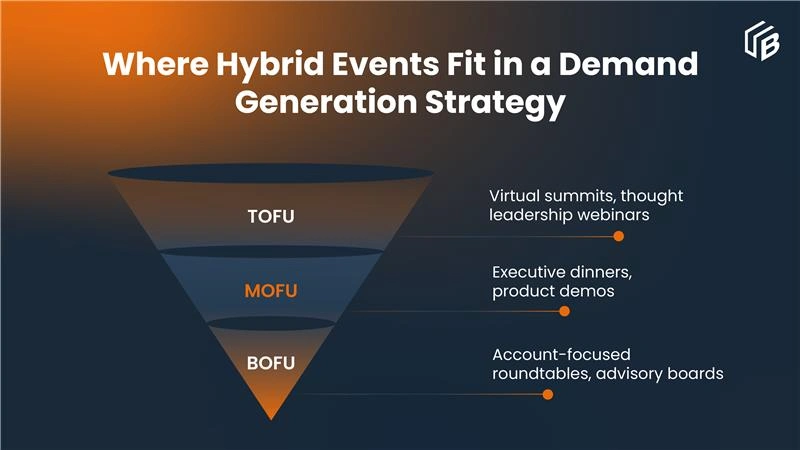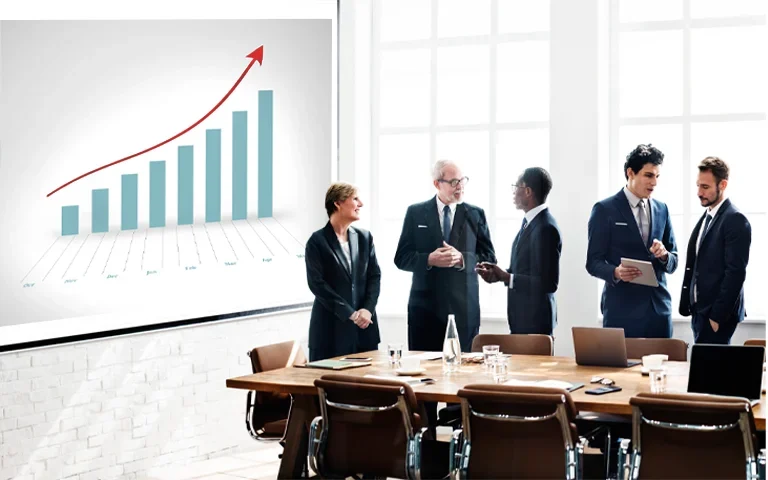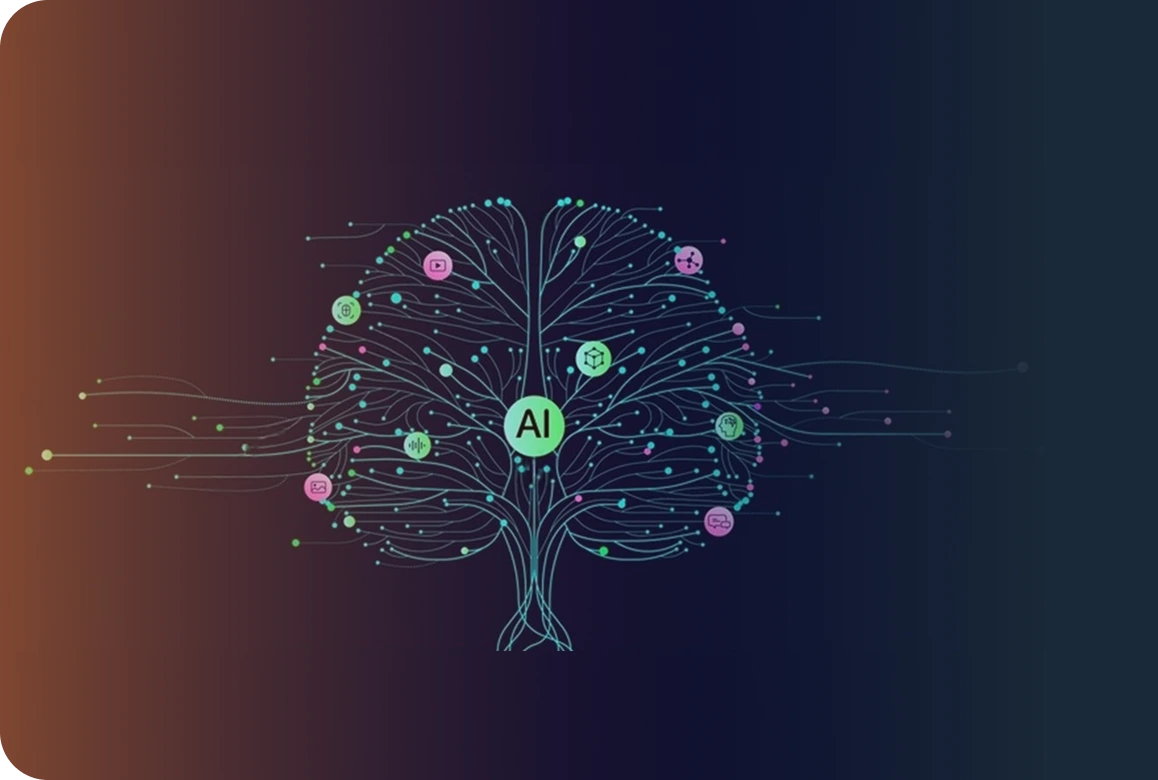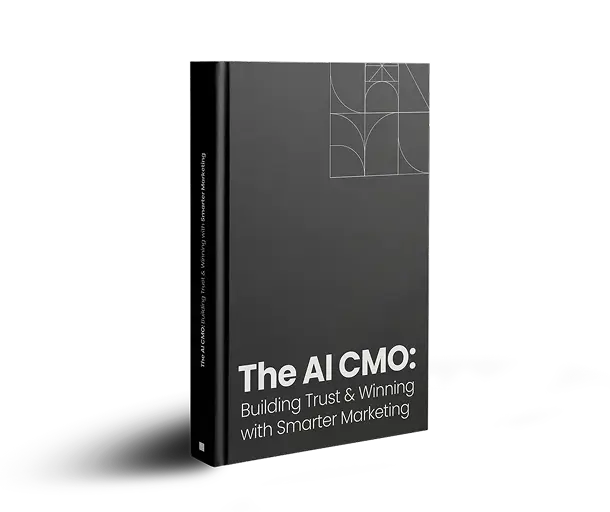
Highlights
- Top 6 hybrid B2B marketing event formats proven to influence pipeline
- Why small, data-driven formats outperform large virtual summits
- How to design demand generation events with sales engagement built-in
- Role of AI and analytics in optimizing hybrid B2B events
- Real-world B2B event strategy examples and benchmarks
- Metrics to measure hybrid event success and ROI
In-person and digital experiences aren’t competing anymore, they’re converging. In 2025, hybrid B2B marketing has become a central driver of demand generation, blending the depth of face-to-face engagement with the scalability of virtual reach. According to Bizzabo, 56.8% of organizers saw year-over-year growth in attendance at in-person B2B events, and 65.8% plan to sustain or increase in-person experiences this year.
These numbers indicate that physical events are evolving into hybrid ecosystems that extend audience reach and content lifespan. However, not every hybrid event drives measurable business impact. The most successful formats are those designed with pipeline performance in mind, where every session, conversation, and follow-up is tied to sales engagement, data capture, and post-event content syndication. In a world where marketing budgets are under pressure, hybrid events that combine human connection with digital intelligence are proving to be the most effective path to sustained growth and revenue impact.
What Are Hybrid B2B Events?
Hybrid B2B marketing events are experiences that seamlessly blend virtual accessibility with in-person engagement, offering the best of both worlds for modern marketers. They’re designed to bring together global audiences without sacrificing the intimacy and relationship-building that happen face-to-face. For example, a company might host a physical executive summit in one city while live-streaming key sessions to remote attendees across regions, ensuring inclusivity and scale.
Why Hybrid Event Formats Still Matter for Pipeline
Hybrid events provide several advantages over strictly virtual or strictly in-person formats:
Broader reach and deeper engagement. You can include remote stakeholders while offering in-person attendees richer interactions.
Better data capture and intent signals. Virtual elements provide engagement metrics that feed lead scoring.
Stretch of content life. Virtual sessions, recordings, and syndication extend influence well beyond the event day.
For instance, 74% of B2B event organizers say they observe a positive ROI at least six months after a virtual event.
Also, hybrid event studies suggest that many organizations (86% in a 2022 hybrid-event survey) report achieving a positive ROI within seven months post-event.
Meanwhile, budget pressure is real. In a recent “Global State of B2B Events 2025” survey, 69% of B2B events leaders said their budgets have either remained flat or decreased.
So success depends on choosing the right hybrid formats, those built around pipeline, not just attendance.
6 Best Hybrid B2B Event Formats for Pipeline Growth
Not every hybrid event drives measurable ROI. The formats that stand out are those purpose-built for engagement, sales enablement, and pipeline acceleration. Below are six hybrid B2B event formats that consistently deliver high-impact demand generation results when executed strategically.
1. Account-Based Executive Roundtables
Exclusive, invite-only roundtables bring together decision-makers from key target accounts for focused discussions around their challenges and priorities. The hybrid model allows a select group to meet in person while enabling senior stakeholders from other regions to join virtually. This setup helps sales teams open doors, strengthen relationships, and move deals closer to conversion.
Pro Tip: Keep these sessions small (10–15 participants) and follow up with personalized content or demos within 48 hours.
2. Virtual + In-Person Product Launches
Product launches thrive in hybrid settings because they combine the energy of live demos with the reach of virtual participation. In-person attendees get hands-on experience, while global audiences can join online, ask questions, and engage in real time.
Using UnboundB2B’s webinar registration and lead generation services, marketers can capture qualified leads from both audiences and feed them directly into CRM workflows for post-event nurturing.
3. Hybrid Industry Summits
Hybrid summits deliver scale and sophistication, offering keynotes, panels, and networking opportunities both on-site and online. When paired with platforms like Unbound Webinar, organizers can ensure synchronized engagement analytics, real-time polls, and Q&A tracking across both audiences.
These summits are ideal for brand authority building, content repurposing, and generating mid-funnel engagement.
Pro Tip: Extend the event’s lifecycle by repurposing recorded sessions into gated assets, podcasts, or short social clips for ongoing demand generation.
4. Localized Executive Dinners + Live Streams
Smaller, regional dinners allow for deeper, relationship-driven conversations among local prospects and customers. By live-streaming key discussions, you can include remote participants, turning a localized gathering into a scalable hybrid experience.
This approach is especially effective for ABM programs and mid-funnel nurturing, where trust and dialogue are crucial to pipeline movement.
5. Data-Driven Virtual Briefings
High-value, data-backed virtual briefings allow you to present insights, reports, or roadmap updates tailored to specific accounts or industries. By integrating UnboundB2B’s webinar technology, you can track detailed engagement metrics, such as attendance duration, questions asked, and interaction levels to score leads and prioritize follow-ups.
These briefings are a cost-efficient way to maintain visibility with key decision-makers and influence deal progression.
6. Hybrid Partner & Customer Advisory Boards
Advisory boards play a vital role in customer retention and expansion. Combining in-person collaboration with virtual participation ensures inclusivity and continuous feedback loops. Hybrid formats help brands gather actionable insights, co-create solutions with partners, and identify upsell opportunities.
Pro Tip: Use post-event surveys and AI-assisted sentiment analysis to gauge satisfaction and shape future engagement strategies.
Pro Insight: In a time of tighter budgets, smaller, high-impact hybrid events often outperform large, expensive summits. Many B2B marketers are shifting toward formats with under 200 attendees, focusing on depth of engagement rather than volume, a strategy that consistently yields better ROI and stronger pipeline influence.
Who Should Own Hybrid B2B Event Strategy
- CMOs & Revenue Leaders: set objectives, define pipeline metrics
- Event Marketing Teams / Agencies: handle logistics, creative, execution
- Sales Teams: engage live, follow up after event
UnboundB2B: as a hybrid & webinar event partner to execute high-impact events at scale
Aligning all parties from the start is key to ensuring that your hybrid event becomes a revenue-driving asset, not just a brand exercise.

How to Run Successful Hybrid Events in B2B
Running a successful hybrid B2B event goes beyond managing logistics, it’s about designing an integrated experience that connects audiences, captures data, and drives measurable pipeline impact. The most effective events combine the precision of digital marketing with the power of human interaction.
Start by choosing the right platform that seamlessly bridges virtual and in-person experiences. Tools like Unbound Webinar, ON24, or Goldcast enable real-time engagement, unified analytics, and cross-channel integration. Then, map your buyer journeys and structure sessions by persona and funnel stage so every attendee, whether virtual or on-site, finds content relevant to their needs.
Next, connect your event data to your CRM and automation workflows. Feeding engagement insights directly into lead scoring models ensures no opportunity is missed.
Use AI and personalization to tailor content delivery, follow-up emails, and recommendations in real time. Finally, repurpose event content, turn panels into blog posts, webinars into video clips, and discussions into sales enablement materials to extend value long after the event ends.
With UnboundB2B’s webinar platform, you can automate registrations, nurture workflows, and track conversions, transforming every hybrid event into a continuous demand engine that fuels long-term growth.
B2B Event Strategy Example
Salesforce’s World Tour Essentials (Hybrid Format)
Objective:
Engage enterprise decision-makers and accelerate the pipeline across regions.
Format:
Salesforce hosts World Tour Essentials, a hybrid series combining local in-person events with global live-streamed sessions. Each stop includes keynote talks, product demos, and customer panels accessible both on-site and virtually.
Execution:
- Regional events in key markets with virtual access for global audiences
- Integrated CRM and marketing automation to track attendee engagement
- Post-event content repurposed into on-demand sessions and social clips
Results:
Salesforce reported tens of thousands of global attendees, strong engagement rates, and measurable pipeline acceleration through personalized follow-ups.
Takeaway:
Like Salesforce, use hybrid formats to blend local connection with global reach, ensuring every event fuels both engagement and revenue growth.
FAQs
1. How Can AI Enhance Hybrid B2B Event Marketing?
AI can personalize session recommendations, predict interest from engagement signals, and help automate post-event follow-up workflows.
2. How do Hybrid B2B Events Support Pipeline Acceleration?
They unify insights from digital and in-person engagement, enabling sales to respond to intent cues and maintain momentum beyond the event day.
3. What is the Role of AI and ChatGPT in Enhancing B2B Event Marketing?
They help with content generation (e.g. promotional copy, summaries), automate engagement sequences, and assist with data-driven insights.
4. What are the Most Effective Marketing Channels for Promoting Hybrid B2B Events?
LinkedIn, email campaigns, partner channels, and retargeting are top avenues, especially when paired with webinar amplification strategies.
Conclusion
Hybrid B2B marketing is about synergy.
The formats that generate pipeline aren’t the ones with the biggest budgets, they’re those built around sales engagement, data capture, and content life extension.
If your 2025 event strategy still treats digital and in-person as separate galaxies, it’s time to evolve.
Next Step: Leverage UnboundB2B’s Webinar Services to design demand generation programs that connect audiences, accelerate pipeline, and deliver measurable ROI.
Our blog
Latest blog posts
Tool and strategies modern teams need to help their companies grow.

B2B Leaders Redefine Demand Generation: Blending Data, Trust & Human Connection. Disc...

Learn how AI-Enhanced Tele-Verification and Account-Based Experience (ABX) together h...

Learn how to improve lead quality and boost conversion rates in B2B with AI enrichmen...






